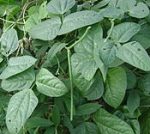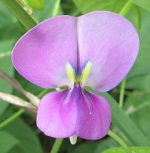 This annual warm season herbaceous legume , also known as black-eye pea, southen pea, niebe, field pea, yardlong bean, and cowder pea, is probably native to west Africa where it grows in semi arid and dry savannahs. It belong to the pea family, Fabiaceae, that also includes beans, locust, and mimosa. Plants have a variety of growth habits from prostrate, to short and bushy, and tall and vine-like. Depending on the variety, cowpea plants are 2-3′ tall and have a tap root and h0llow, hairless stems. The 4″ long leaves are hairless and divided into three ovate leaflets with only the terminal one being symmetrical. Terminal clusters of three purple or white, 1″ long flowers appear in summer and give way to curved seed pods up to 10″ long that are usually green, pourple or yellow before turning tan or brown when the seeds reach maturity. Each pod contains 6-13 kidney shaped seeds that are white with a black mark in the place where it was attached to the pod. Cowpeas have long been a source of protein for people in developing countries but has also been used as feed for cattle, control of soil erosion, and green manure. The genus name, Vigna, honors the Italian botanist Domenica Vigna. The specific epithet, unguiculata, comes from the Latin word unguis meaning claw, and refers to the small stalks on the flower petals.
This annual warm season herbaceous legume , also known as black-eye pea, southen pea, niebe, field pea, yardlong bean, and cowder pea, is probably native to west Africa where it grows in semi arid and dry savannahs. It belong to the pea family, Fabiaceae, that also includes beans, locust, and mimosa. Plants have a variety of growth habits from prostrate, to short and bushy, and tall and vine-like. Depending on the variety, cowpea plants are 2-3′ tall and have a tap root and h0llow, hairless stems. The 4″ long leaves are hairless and divided into three ovate leaflets with only the terminal one being symmetrical. Terminal clusters of three purple or white, 1″ long flowers appear in summer and give way to curved seed pods up to 10″ long that are usually green, pourple or yellow before turning tan or brown when the seeds reach maturity. Each pod contains 6-13 kidney shaped seeds that are white with a black mark in the place where it was attached to the pod. Cowpeas have long been a source of protein for people in developing countries but has also been used as feed for cattle, control of soil erosion, and green manure. The genus name, Vigna, honors the Italian botanist Domenica Vigna. The specific epithet, unguiculata, comes from the Latin word unguis meaning claw, and refers to the small stalks on the flower petals.
 Type: Warm season annual
Type: Warm season annual
Bloom: Small clusters of white to purple flowers in summer
Size: 2-3′ H
Light:Full sun to light shade
Soil: Average to lean, dry to mediium moist, well-drained
Hardiness: Not applicable
Care: Low maintenance
Pests and Diseases: fusarium wilt (Fusarium oxysporum), bacterial canker, southern stem bligh(Sclerotium spp.), cowpea mosaic virus, cercospora leafspot, rust, and powdery mildew (Podosphaera spp.) Mexican bean beetles (Epilachna varivestis), bean leaf beetles (Cerotoma trifucata), cowpea curculios (Chalcodermus aeneus), grasshoppers, aphids, green stink bugs, lesser cornstalk borers
Propagation: Seed (plants tend to self seed)
Companion Plants: Not applicable
Photo Credits:Wikipedia